Exploring Flickr: Web 2.0, Amateur Photography, and Social Impact
VerifiedAdded on 2023/03/24
|10
|2412
|94
Report
AI Summary
This report provides a comprehensive analysis of Flickr as a prominent example of Web 2.0, focusing on its functionalities and impact on amateur photography and online communities. It examines Flickr's evolution from a social game to a commercial website driven by user participation, ev...

Flickr Web 2.0
Paraphrase This Document
Need a fresh take? Get an instant paraphrase of this document with our AI Paraphraser
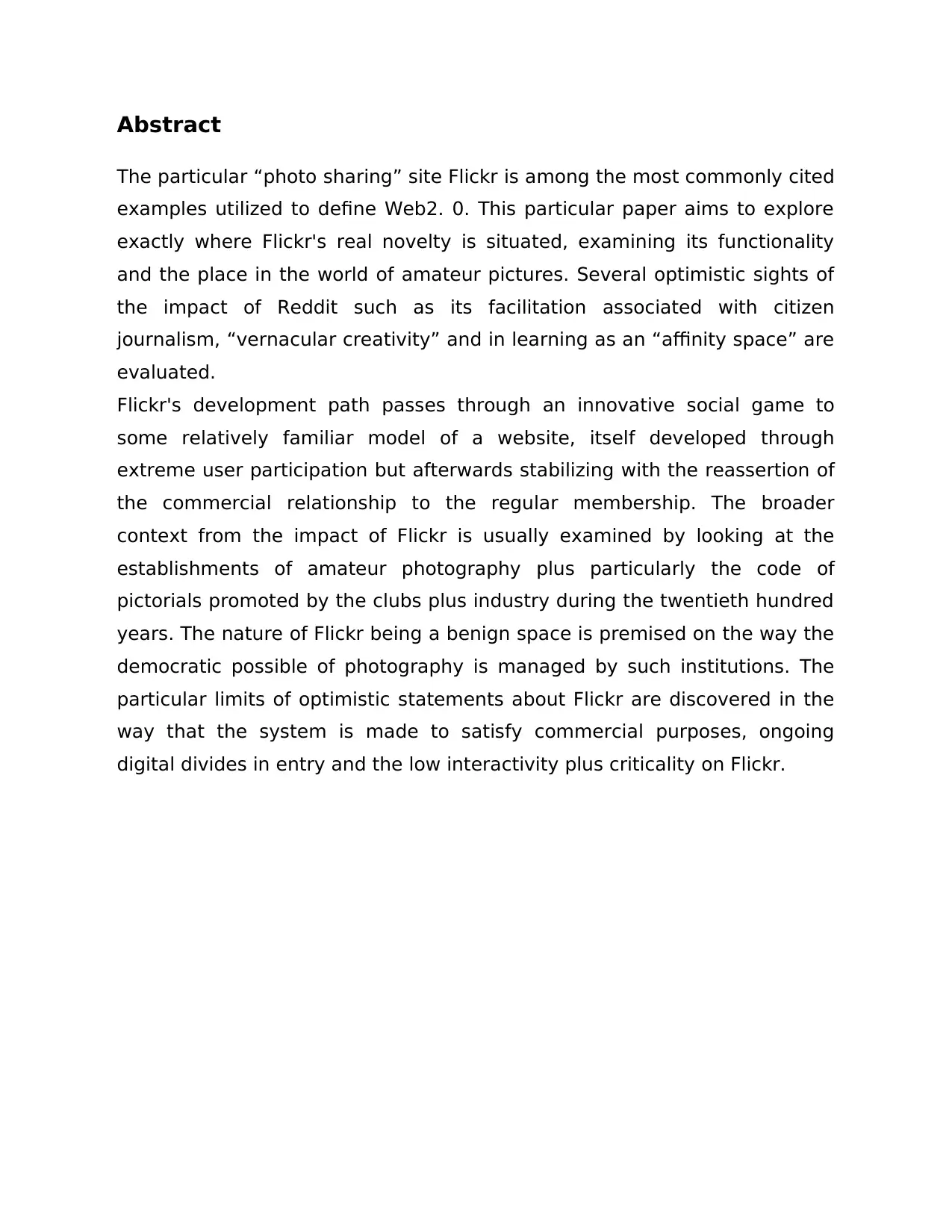
Abstract
The particular “photo sharing” site Flickr is among the most commonly cited
examples utilized to define Web2. 0. This particular paper aims to explore
exactly where Flickr's real novelty is situated, examining its functionality
and the place in the world of amateur pictures. Several optimistic sights of
the impact of Reddit such as its facilitation associated with citizen
journalism, “vernacular creativity” and in learning as an “affinity space” are
evaluated.
Flickr's development path passes through an innovative social game to
some relatively familiar model of a website, itself developed through
extreme user participation but afterwards stabilizing with the reassertion of
the commercial relationship to the regular membership. The broader
context from the impact of Flickr is usually examined by looking at the
establishments of amateur photography plus particularly the code of
pictorials promoted by the clubs plus industry during the twentieth hundred
years. The nature of Flickr being a benign space is premised on the way the
democratic possible of photography is managed by such institutions. The
particular limits of optimistic statements about Flickr are discovered in the
way that the system is made to satisfy commercial purposes, ongoing
digital divides in entry and the low interactivity plus criticality on Flickr.
The particular “photo sharing” site Flickr is among the most commonly cited
examples utilized to define Web2. 0. This particular paper aims to explore
exactly where Flickr's real novelty is situated, examining its functionality
and the place in the world of amateur pictures. Several optimistic sights of
the impact of Reddit such as its facilitation associated with citizen
journalism, “vernacular creativity” and in learning as an “affinity space” are
evaluated.
Flickr's development path passes through an innovative social game to
some relatively familiar model of a website, itself developed through
extreme user participation but afterwards stabilizing with the reassertion of
the commercial relationship to the regular membership. The broader
context from the impact of Flickr is usually examined by looking at the
establishments of amateur photography plus particularly the code of
pictorials promoted by the clubs plus industry during the twentieth hundred
years. The nature of Flickr being a benign space is premised on the way the
democratic possible of photography is managed by such institutions. The
particular limits of optimistic statements about Flickr are discovered in the
way that the system is made to satisfy commercial purposes, ongoing
digital divides in entry and the low interactivity plus criticality on Flickr.
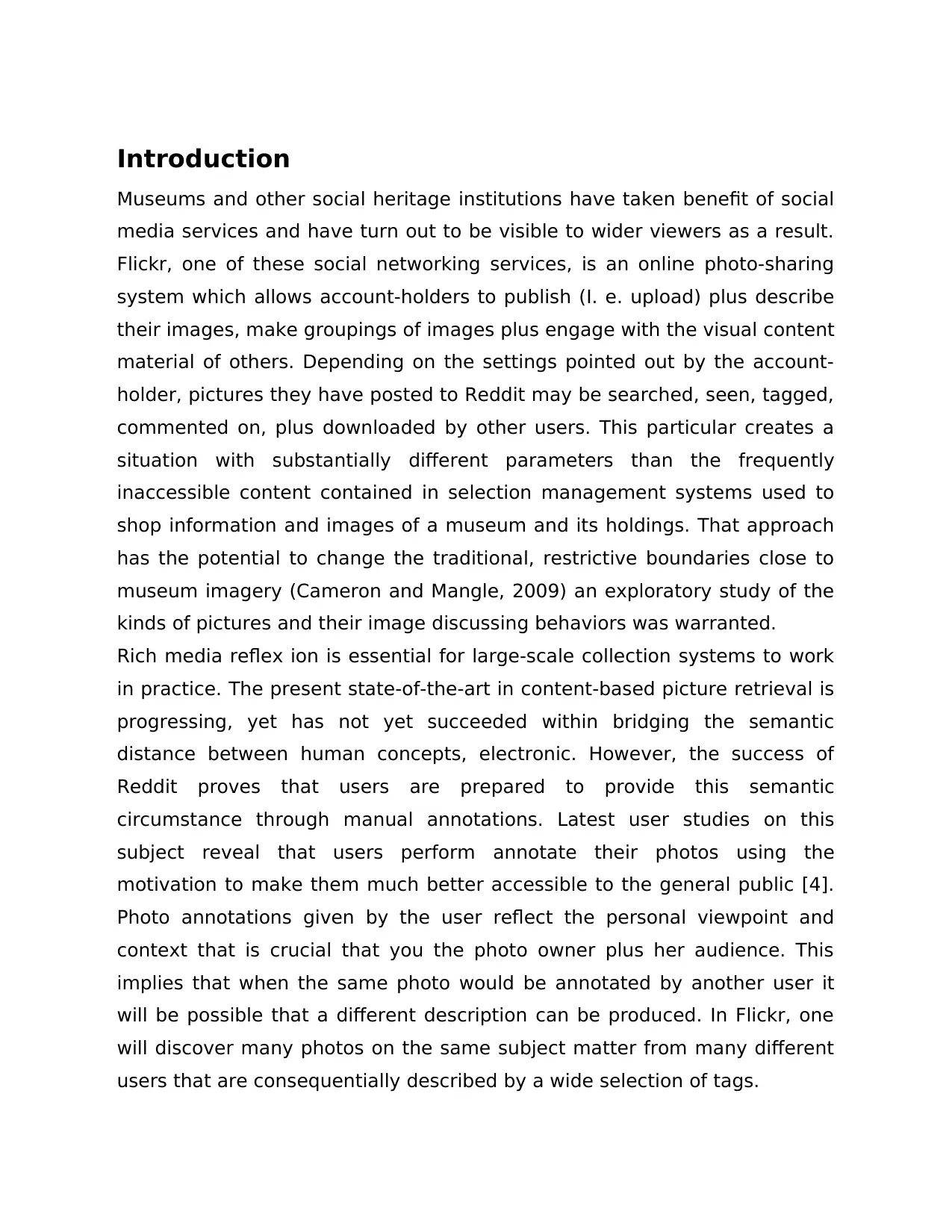
Introduction
Museums and other social heritage institutions have taken benefit of social
media services and have turn out to be visible to wider viewers as a result.
Flickr, one of these social networking services, is an online photo-sharing
system which allows account-holders to publish (I. e. upload) plus describe
their images, make groupings of images plus engage with the visual content
material of others. Depending on the settings pointed out by the account-
holder, pictures they have posted to Reddit may be searched, seen, tagged,
commented on, plus downloaded by other users. This particular creates a
situation with substantially different parameters than the frequently
inaccessible content contained in selection management systems used to
shop information and images of a museum and its holdings. That approach
has the potential to change the traditional, restrictive boundaries close to
museum imagery (Cameron and Mangle, 2009) an exploratory study of the
kinds of pictures and their image discussing behaviors was warranted.
Rich media reflex ion is essential for large-scale collection systems to work
in practice. The present state-of-the-art in content-based picture retrieval is
progressing, yet has not yet succeeded within bridging the semantic
distance between human concepts, electronic. However, the success of
Reddit proves that users are prepared to provide this semantic
circumstance through manual annotations. Latest user studies on this
subject reveal that users perform annotate their photos using the
motivation to make them much better accessible to the general public [4].
Photo annotations given by the user reflect the personal viewpoint and
context that is crucial that you the photo owner plus her audience. This
implies that when the same photo would be annotated by another user it
will be possible that a different description can be produced. In Flickr, one
will discover many photos on the same subject matter from many different
users that are consequentially described by a wide selection of tags.
Museums and other social heritage institutions have taken benefit of social
media services and have turn out to be visible to wider viewers as a result.
Flickr, one of these social networking services, is an online photo-sharing
system which allows account-holders to publish (I. e. upload) plus describe
their images, make groupings of images plus engage with the visual content
material of others. Depending on the settings pointed out by the account-
holder, pictures they have posted to Reddit may be searched, seen, tagged,
commented on, plus downloaded by other users. This particular creates a
situation with substantially different parameters than the frequently
inaccessible content contained in selection management systems used to
shop information and images of a museum and its holdings. That approach
has the potential to change the traditional, restrictive boundaries close to
museum imagery (Cameron and Mangle, 2009) an exploratory study of the
kinds of pictures and their image discussing behaviors was warranted.
Rich media reflex ion is essential for large-scale collection systems to work
in practice. The present state-of-the-art in content-based picture retrieval is
progressing, yet has not yet succeeded within bridging the semantic
distance between human concepts, electronic. However, the success of
Reddit proves that users are prepared to provide this semantic
circumstance through manual annotations. Latest user studies on this
subject reveal that users perform annotate their photos using the
motivation to make them much better accessible to the general public [4].
Photo annotations given by the user reflect the personal viewpoint and
context that is crucial that you the photo owner plus her audience. This
implies that when the same photo would be annotated by another user it
will be possible that a different description can be produced. In Flickr, one
will discover many photos on the same subject matter from many different
users that are consequentially described by a wide selection of tags.
⊘ This is a preview!⊘
Do you want full access?
Subscribe today to unlock all pages.

Trusted by 1+ million students worldwide
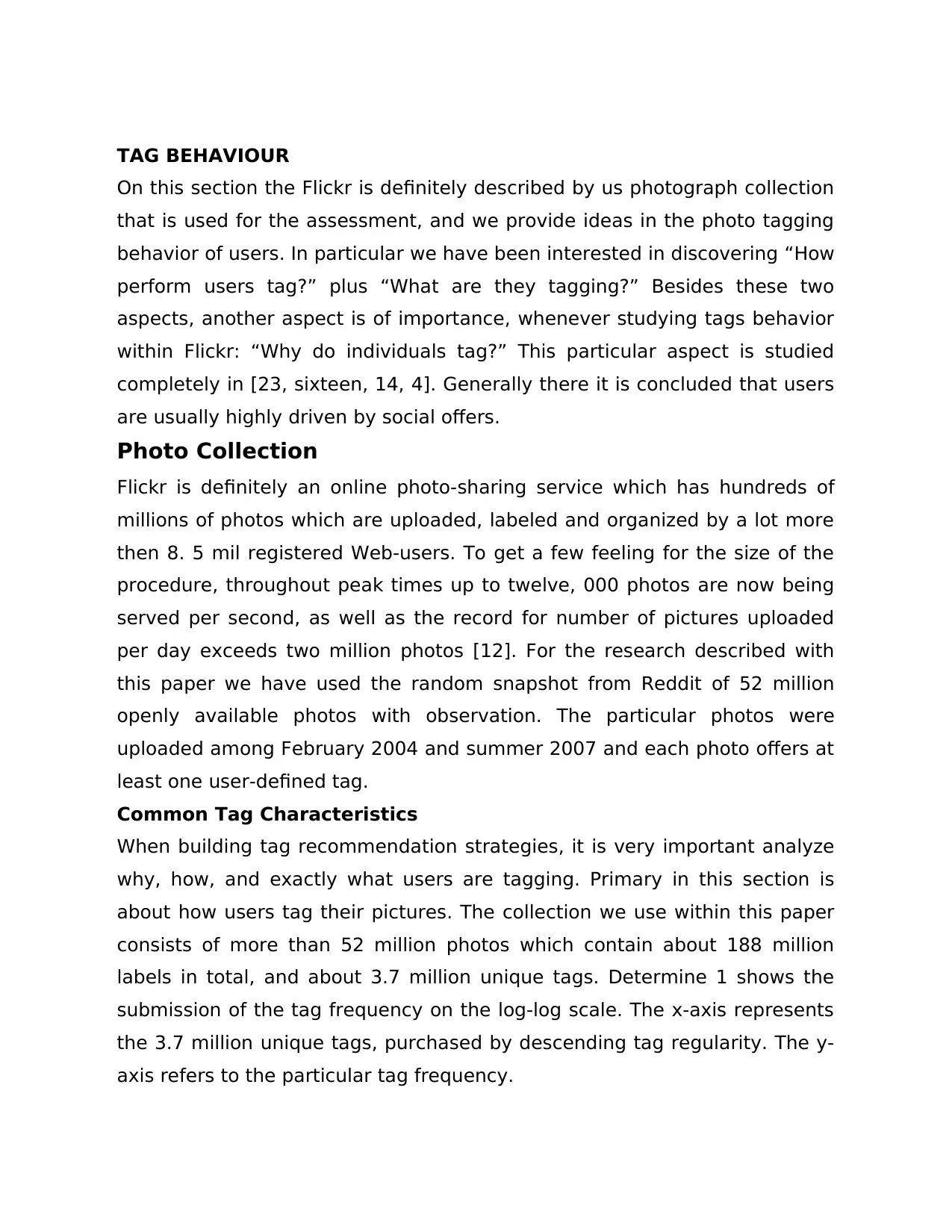
TAG BEHAVIOUR
On this section the Flickr is definitely described by us photograph collection
that is used for the assessment, and we provide ideas in the photo tagging
behavior of users. In particular we have been interested in discovering “How
perform users tag?” plus “What are they tagging?” Besides these two
aspects, another aspect is of importance, whenever studying tags behavior
within Flickr: “Why do individuals tag?” This particular aspect is studied
completely in [23, sixteen, 14, 4]. Generally there it is concluded that users
are usually highly driven by social offers.
Photo Collection
Flickr is definitely an online photo-sharing service which has hundreds of
millions of photos which are uploaded, labeled and organized by a lot more
then 8. 5 mil registered Web-users. To get a few feeling for the size of the
procedure, throughout peak times up to twelve, 000 photos are now being
served per second, as well as the record for number of pictures uploaded
per day exceeds two million photos [12]. For the research described with
this paper we have used the random snapshot from Reddit of 52 million
openly available photos with observation. The particular photos were
uploaded among February 2004 and summer 2007 and each photo offers at
least one user-defined tag.
Common Tag Characteristics
When building tag recommendation strategies, it is very important analyze
why, how, and exactly what users are tagging. Primary in this section is
about how users tag their pictures. The collection we use within this paper
consists of more than 52 million photos which contain about 188 million
labels in total, and about 3.7 million unique tags. Determine 1 shows the
submission of the tag frequency on the log-log scale. The x-axis represents
the 3.7 million unique tags, purchased by descending tag regularity. The y-
axis refers to the particular tag frequency.
On this section the Flickr is definitely described by us photograph collection
that is used for the assessment, and we provide ideas in the photo tagging
behavior of users. In particular we have been interested in discovering “How
perform users tag?” plus “What are they tagging?” Besides these two
aspects, another aspect is of importance, whenever studying tags behavior
within Flickr: “Why do individuals tag?” This particular aspect is studied
completely in [23, sixteen, 14, 4]. Generally there it is concluded that users
are usually highly driven by social offers.
Photo Collection
Flickr is definitely an online photo-sharing service which has hundreds of
millions of photos which are uploaded, labeled and organized by a lot more
then 8. 5 mil registered Web-users. To get a few feeling for the size of the
procedure, throughout peak times up to twelve, 000 photos are now being
served per second, as well as the record for number of pictures uploaded
per day exceeds two million photos [12]. For the research described with
this paper we have used the random snapshot from Reddit of 52 million
openly available photos with observation. The particular photos were
uploaded among February 2004 and summer 2007 and each photo offers at
least one user-defined tag.
Common Tag Characteristics
When building tag recommendation strategies, it is very important analyze
why, how, and exactly what users are tagging. Primary in this section is
about how users tag their pictures. The collection we use within this paper
consists of more than 52 million photos which contain about 188 million
labels in total, and about 3.7 million unique tags. Determine 1 shows the
submission of the tag frequency on the log-log scale. The x-axis represents
the 3.7 million unique tags, purchased by descending tag regularity. The y-
axis refers to the particular tag frequency.
Paraphrase This Document
Need a fresh take? Get an instant paraphrase of this document with our AI Paraphraser
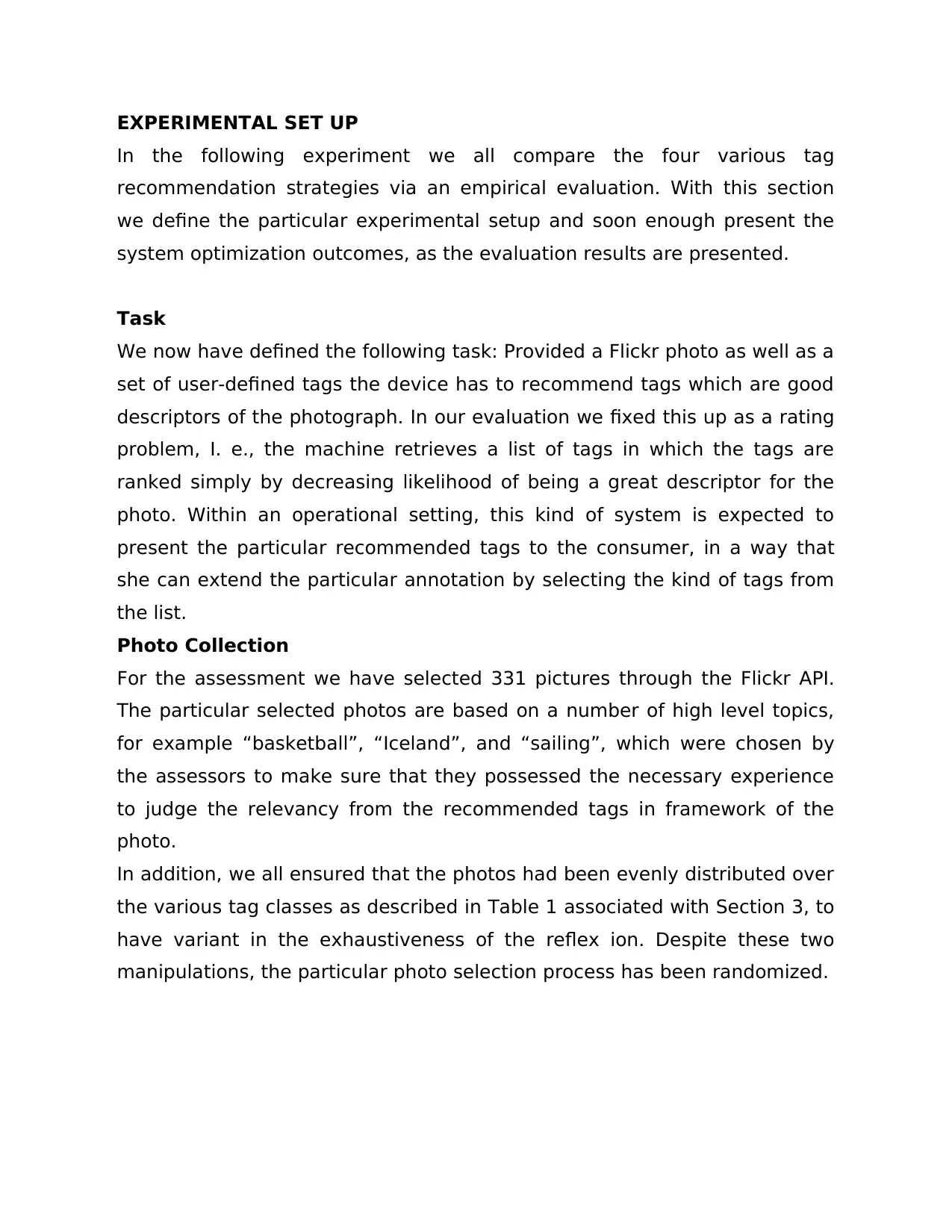
EXPERIMENTAL SET UP
In the following experiment we all compare the four various tag
recommendation strategies via an empirical evaluation. With this section
we define the particular experimental setup and soon enough present the
system optimization outcomes, as the evaluation results are presented.
Task
We now have defined the following task: Provided a Flickr photo as well as a
set of user-defined tags the device has to recommend tags which are good
descriptors of the photograph. In our evaluation we fixed this up as a rating
problem, I. e., the machine retrieves a list of tags in which the tags are
ranked simply by decreasing likelihood of being a great descriptor for the
photo. Within an operational setting, this kind of system is expected to
present the particular recommended tags to the consumer, in a way that
she can extend the particular annotation by selecting the kind of tags from
the list.
Photo Collection
For the assessment we have selected 331 pictures through the Flickr API.
The particular selected photos are based on a number of high level topics,
for example “basketball”, “Iceland”, and “sailing”, which were chosen by
the assessors to make sure that they possessed the necessary experience
to judge the relevancy from the recommended tags in framework of the
photo.
In addition, we all ensured that the photos had been evenly distributed over
the various tag classes as described in Table 1 associated with Section 3, to
have variant in the exhaustiveness of the reflex ion. Despite these two
manipulations, the particular photo selection process has been randomized.
In the following experiment we all compare the four various tag
recommendation strategies via an empirical evaluation. With this section
we define the particular experimental setup and soon enough present the
system optimization outcomes, as the evaluation results are presented.
Task
We now have defined the following task: Provided a Flickr photo as well as a
set of user-defined tags the device has to recommend tags which are good
descriptors of the photograph. In our evaluation we fixed this up as a rating
problem, I. e., the machine retrieves a list of tags in which the tags are
ranked simply by decreasing likelihood of being a great descriptor for the
photo. Within an operational setting, this kind of system is expected to
present the particular recommended tags to the consumer, in a way that
she can extend the particular annotation by selecting the kind of tags from
the list.
Photo Collection
For the assessment we have selected 331 pictures through the Flickr API.
The particular selected photos are based on a number of high level topics,
for example “basketball”, “Iceland”, and “sailing”, which were chosen by
the assessors to make sure that they possessed the necessary experience
to judge the relevancy from the recommended tags in framework of the
photo.
In addition, we all ensured that the photos had been evenly distributed over
the various tag classes as described in Table 1 associated with Section 3, to
have variant in the exhaustiveness of the reflex ion. Despite these two
manipulations, the particular photo selection process has been randomized.

FLICKR GROUPS
The term “group” has several meanings in the English language, yet we find
two of them to become most representatives for Reddit groups:
o “An assemblage of individuals or objects gathered or even located
Together”;
o “A number of individuals or things regarded as together because of
similarities”.
An organization is a collection of persons or even objects therefore, that is
either in physical closeness or shares some fuzzy characteristics. On Flickr,
from the technical point of view strictly, groupings are collections of
customers who choose to join this kind of community freely. The main
purpose of groupings is to facilitate the revealing of user photos about what
is called the group pool. This can be a collection of photos shared simply by
any known member with the entire group, and, implicitly, all of the tags
associated with the photo turn out to be part of the group photo swimming
pool.
You can distinguish between several types of groups, which might
sometimes be intertwined. A short, non-exhaustive list can include:
o geographical/event organizations: groups limited to a physical region
or a specific occasion (local or global), like New York City, San
Francisco Bay, Swiss, Live Music, World Occasions ( festivals, protests,
and so forth ), Global Photojournalism;
o content groups: groups mainly oriented towards the visual articles
being shared, such as L is for Red, Leaves (No Trees Please! ), Cats
and kittens - Small to Huge, Artistic Child Photography;
o visual style groups: organizations that concentrate on a specific photo
taking technique, one example is Life in White plus Black, Closer plus
Closer Macro Photography;
The term “group” has several meanings in the English language, yet we find
two of them to become most representatives for Reddit groups:
o “An assemblage of individuals or objects gathered or even located
Together”;
o “A number of individuals or things regarded as together because of
similarities”.
An organization is a collection of persons or even objects therefore, that is
either in physical closeness or shares some fuzzy characteristics. On Flickr,
from the technical point of view strictly, groupings are collections of
customers who choose to join this kind of community freely. The main
purpose of groupings is to facilitate the revealing of user photos about what
is called the group pool. This can be a collection of photos shared simply by
any known member with the entire group, and, implicitly, all of the tags
associated with the photo turn out to be part of the group photo swimming
pool.
You can distinguish between several types of groups, which might
sometimes be intertwined. A short, non-exhaustive list can include:
o geographical/event organizations: groups limited to a physical region
or a specific occasion (local or global), like New York City, San
Francisco Bay, Swiss, Live Music, World Occasions ( festivals, protests,
and so forth ), Global Photojournalism;
o content groups: groups mainly oriented towards the visual articles
being shared, such as L is for Red, Leaves (No Trees Please! ), Cats
and kittens - Small to Huge, Artistic Child Photography;
o visual style groups: organizations that concentrate on a specific photo
taking technique, one example is Life in White plus Black, Closer plus
Closer Macro Photography;
⊘ This is a preview!⊘
Do you want full access?
Subscribe today to unlock all pages.

Trusted by 1+ million students worldwide
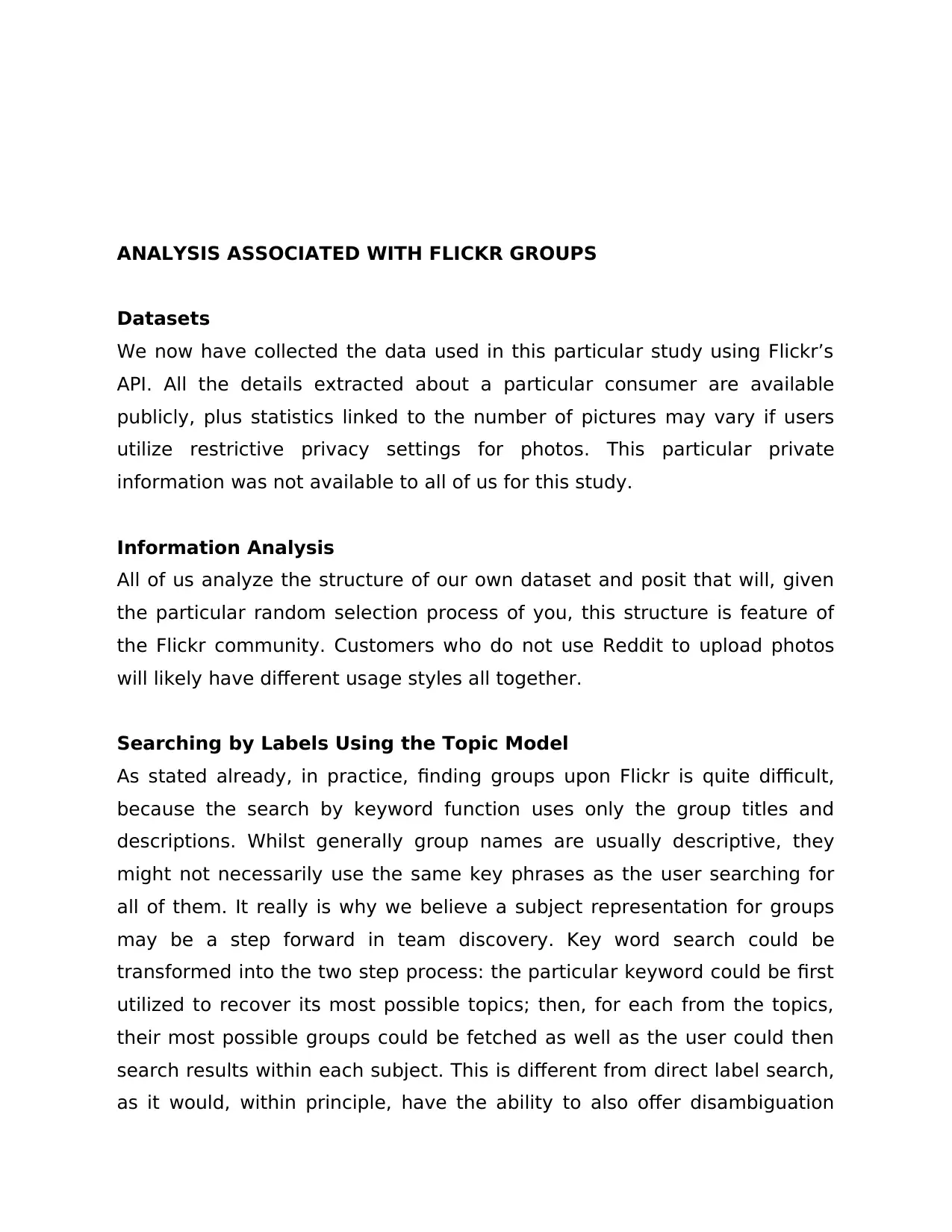
ANALYSIS ASSOCIATED WITH FLICKR GROUPS
Datasets
We now have collected the data used in this particular study using Flickr’s
API. All the details extracted about a particular consumer are available
publicly, plus statistics linked to the number of pictures may vary if users
utilize restrictive privacy settings for photos. This particular private
information was not available to all of us for this study.
Information Analysis
All of us analyze the structure of our own dataset and posit that will, given
the particular random selection process of you, this structure is feature of
the Flickr community. Customers who do not use Reddit to upload photos
will likely have different usage styles all together.
Searching by Labels Using the Topic Model
As stated already, in practice, finding groups upon Flickr is quite difficult,
because the search by keyword function uses only the group titles and
descriptions. Whilst generally group names are usually descriptive, they
might not necessarily use the same key phrases as the user searching for
all of them. It really is why we believe a subject representation for groups
may be a step forward in team discovery. Key word search could be
transformed into the two step process: the particular keyword could be first
utilized to recover its most possible topics; then, for each from the topics,
their most possible groups could be fetched as well as the user could then
search results within each subject. This is different from direct label search,
as it would, within principle, have the ability to also offer disambiguation
Datasets
We now have collected the data used in this particular study using Flickr’s
API. All the details extracted about a particular consumer are available
publicly, plus statistics linked to the number of pictures may vary if users
utilize restrictive privacy settings for photos. This particular private
information was not available to all of us for this study.
Information Analysis
All of us analyze the structure of our own dataset and posit that will, given
the particular random selection process of you, this structure is feature of
the Flickr community. Customers who do not use Reddit to upload photos
will likely have different usage styles all together.
Searching by Labels Using the Topic Model
As stated already, in practice, finding groups upon Flickr is quite difficult,
because the search by keyword function uses only the group titles and
descriptions. Whilst generally group names are usually descriptive, they
might not necessarily use the same key phrases as the user searching for
all of them. It really is why we believe a subject representation for groups
may be a step forward in team discovery. Key word search could be
transformed into the two step process: the particular keyword could be first
utilized to recover its most possible topics; then, for each from the topics,
their most possible groups could be fetched as well as the user could then
search results within each subject. This is different from direct label search,
as it would, within principle, have the ability to also offer disambiguation
Paraphrase This Document
Need a fresh take? Get an instant paraphrase of this document with our AI Paraphraser
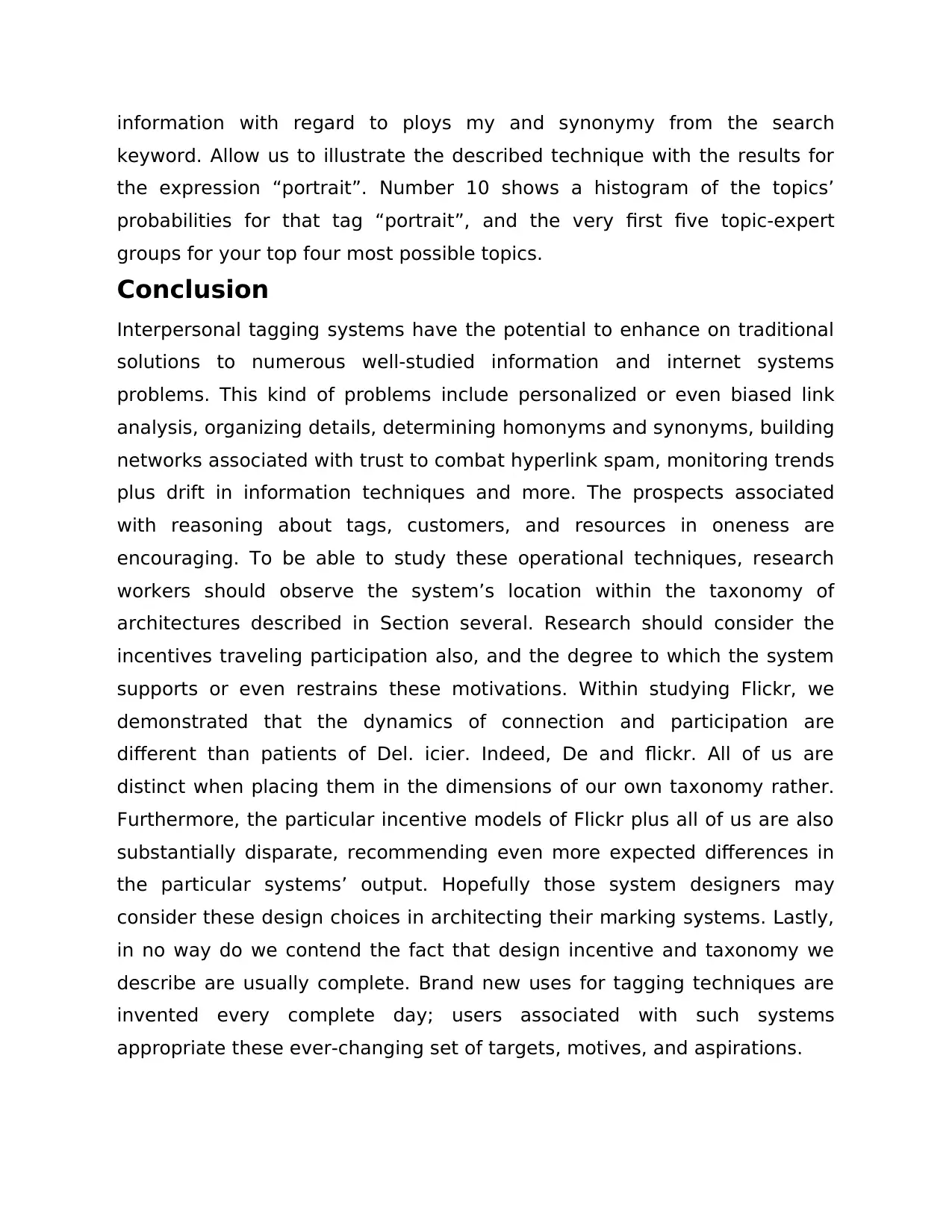
information with regard to ploys my and synonymy from the search
keyword. Allow us to illustrate the described technique with the results for
the expression “portrait”. Number 10 shows a histogram of the topics’
probabilities for that tag “portrait”, and the very first five topic-expert
groups for your top four most possible topics.
Conclusion
Interpersonal tagging systems have the potential to enhance on traditional
solutions to numerous well-studied information and internet systems
problems. This kind of problems include personalized or even biased link
analysis, organizing details, determining homonyms and synonyms, building
networks associated with trust to combat hyperlink spam, monitoring trends
plus drift in information techniques and more. The prospects associated
with reasoning about tags, customers, and resources in oneness are
encouraging. To be able to study these operational techniques, research
workers should observe the system’s location within the taxonomy of
architectures described in Section several. Research should consider the
incentives traveling participation also, and the degree to which the system
supports or even restrains these motivations. Within studying Flickr, we
demonstrated that the dynamics of connection and participation are
different than patients of Del. icier. Indeed, De and flickr. All of us are
distinct when placing them in the dimensions of our own taxonomy rather.
Furthermore, the particular incentive models of Flickr plus all of us are also
substantially disparate, recommending even more expected differences in
the particular systems’ output. Hopefully those system designers may
consider these design choices in architecting their marking systems. Lastly,
in no way do we contend the fact that design incentive and taxonomy we
describe are usually complete. Brand new uses for tagging techniques are
invented every complete day; users associated with such systems
appropriate these ever-changing set of targets, motives, and aspirations.
keyword. Allow us to illustrate the described technique with the results for
the expression “portrait”. Number 10 shows a histogram of the topics’
probabilities for that tag “portrait”, and the very first five topic-expert
groups for your top four most possible topics.
Conclusion
Interpersonal tagging systems have the potential to enhance on traditional
solutions to numerous well-studied information and internet systems
problems. This kind of problems include personalized or even biased link
analysis, organizing details, determining homonyms and synonyms, building
networks associated with trust to combat hyperlink spam, monitoring trends
plus drift in information techniques and more. The prospects associated
with reasoning about tags, customers, and resources in oneness are
encouraging. To be able to study these operational techniques, research
workers should observe the system’s location within the taxonomy of
architectures described in Section several. Research should consider the
incentives traveling participation also, and the degree to which the system
supports or even restrains these motivations. Within studying Flickr, we
demonstrated that the dynamics of connection and participation are
different than patients of Del. icier. Indeed, De and flickr. All of us are
distinct when placing them in the dimensions of our own taxonomy rather.
Furthermore, the particular incentive models of Flickr plus all of us are also
substantially disparate, recommending even more expected differences in
the particular systems’ output. Hopefully those system designers may
consider these design choices in architecting their marking systems. Lastly,
in no way do we contend the fact that design incentive and taxonomy we
describe are usually complete. Brand new uses for tagging techniques are
invented every complete day; users associated with such systems
appropriate these ever-changing set of targets, motives, and aspirations.
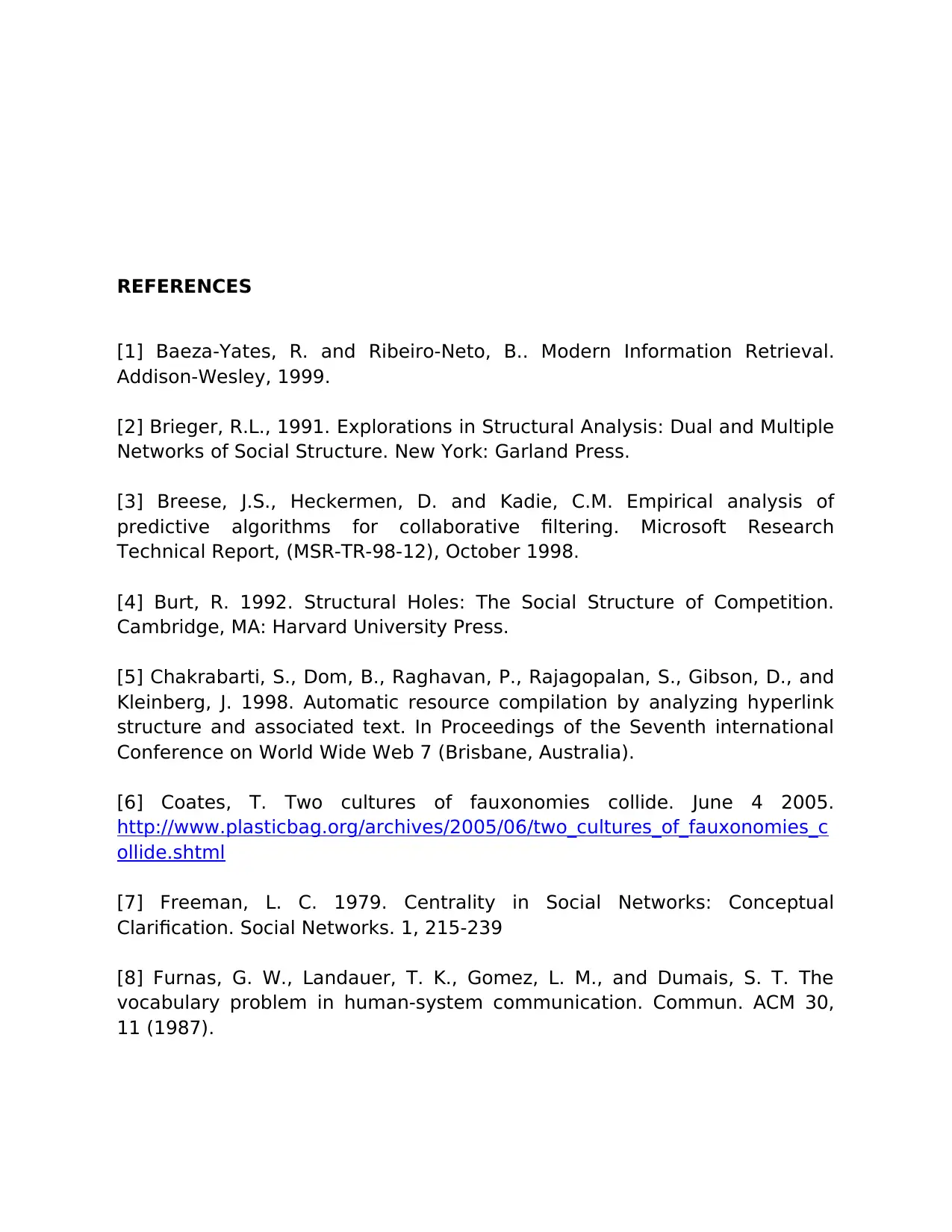
REFERENCES
[1] Baeza-Yates, R. and Ribeiro-Neto, B.. Modern Information Retrieval.
Addison-Wesley, 1999.
[2] Brieger, R.L., 1991. Explorations in Structural Analysis: Dual and Multiple
Networks of Social Structure. New York: Garland Press.
[3] Breese, J.S., Heckermen, D. and Kadie, C.M. Empirical analysis of
predictive algorithms for collaborative filtering. Microsoft Research
Technical Report, (MSR-TR-98-12), October 1998.
[4] Burt, R. 1992. Structural Holes: The Social Structure of Competition.
Cambridge, MA: Harvard University Press.
[5] Chakrabarti, S., Dom, B., Raghavan, P., Rajagopalan, S., Gibson, D., and
Kleinberg, J. 1998. Automatic resource compilation by analyzing hyperlink
structure and associated text. In Proceedings of the Seventh international
Conference on World Wide Web 7 (Brisbane, Australia).
[6] Coates, T. Two cultures of fauxonomies collide. June 4 2005.
http://www.plasticbag.org/archives/2005/06/two_cultures_of_fauxonomies_c
ollide.shtml
[7] Freeman, L. C. 1979. Centrality in Social Networks: Conceptual
Clarification. Social Networks. 1, 215-239
[8] Furnas, G. W., Landauer, T. K., Gomez, L. M., and Dumais, S. T. The
vocabulary problem in human-system communication. Commun. ACM 30,
11 (1987).
[1] Baeza-Yates, R. and Ribeiro-Neto, B.. Modern Information Retrieval.
Addison-Wesley, 1999.
[2] Brieger, R.L., 1991. Explorations in Structural Analysis: Dual and Multiple
Networks of Social Structure. New York: Garland Press.
[3] Breese, J.S., Heckermen, D. and Kadie, C.M. Empirical analysis of
predictive algorithms for collaborative filtering. Microsoft Research
Technical Report, (MSR-TR-98-12), October 1998.
[4] Burt, R. 1992. Structural Holes: The Social Structure of Competition.
Cambridge, MA: Harvard University Press.
[5] Chakrabarti, S., Dom, B., Raghavan, P., Rajagopalan, S., Gibson, D., and
Kleinberg, J. 1998. Automatic resource compilation by analyzing hyperlink
structure and associated text. In Proceedings of the Seventh international
Conference on World Wide Web 7 (Brisbane, Australia).
[6] Coates, T. Two cultures of fauxonomies collide. June 4 2005.
http://www.plasticbag.org/archives/2005/06/two_cultures_of_fauxonomies_c
ollide.shtml
[7] Freeman, L. C. 1979. Centrality in Social Networks: Conceptual
Clarification. Social Networks. 1, 215-239
[8] Furnas, G. W., Landauer, T. K., Gomez, L. M., and Dumais, S. T. The
vocabulary problem in human-system communication. Commun. ACM 30,
11 (1987).
⊘ This is a preview!⊘
Do you want full access?
Subscribe today to unlock all pages.

Trusted by 1+ million students worldwide

[9] Golder, S., and Huberman, B. A. The Structure of Collaborative Tagging
Systems. HP Labs technical report, 2005. Available from
http://www.hpl.hp.com/research/idl/papers/tags/
Systems. HP Labs technical report, 2005. Available from
http://www.hpl.hp.com/research/idl/papers/tags/
1 out of 10
Your All-in-One AI-Powered Toolkit for Academic Success.
+13062052269
info@desklib.com
Available 24*7 on WhatsApp / Email
![[object Object]](/_next/static/media/star-bottom.7253800d.svg)
Unlock your academic potential
© 2024 | Zucol Services PVT LTD | All rights reserved.
